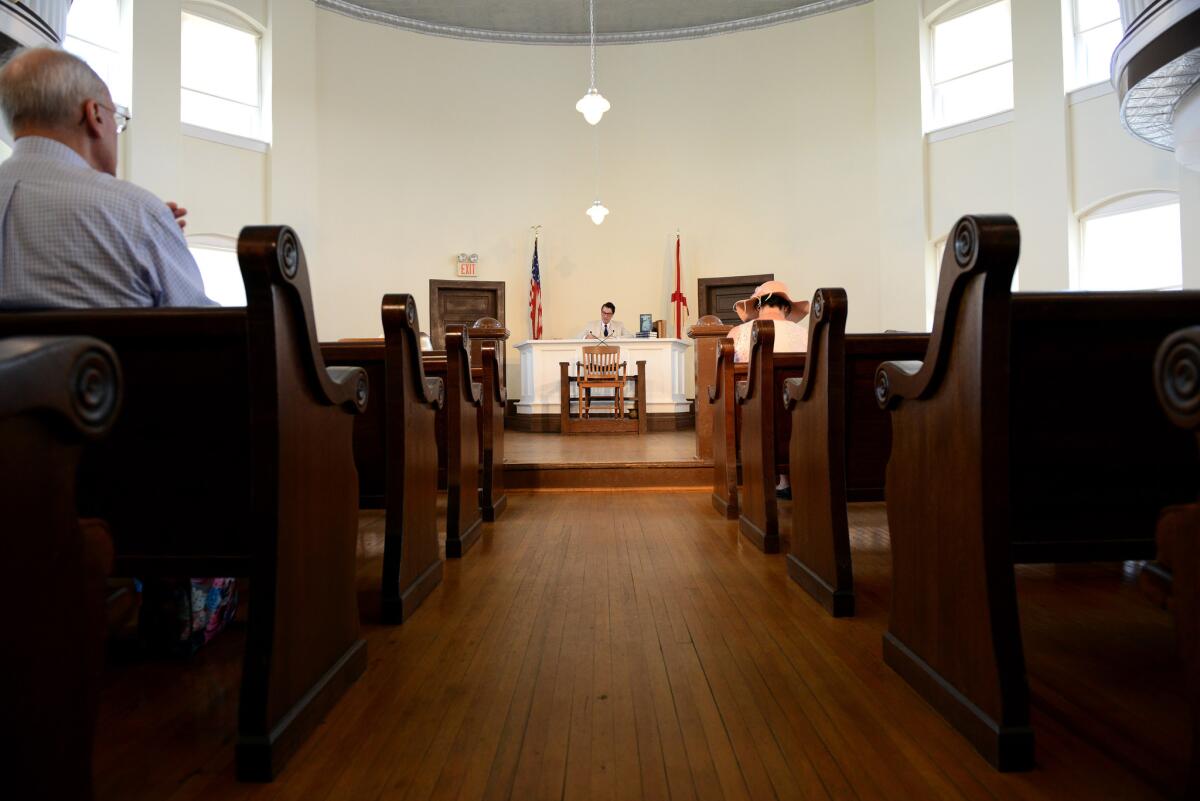Harper Lee’s legacy looms over ‘Watchman’ celebrations in Monroeville, Ala.

Festivities for the launch of “Go Set a Watchman” in Harper Lee’s hometown of Monroeville, Ala., included readings in the old courthouse.
- Share via
The day after the release of “Go Set a Watchman,” I am sitting alone in the famous balcony of the Monroe County Courthouse in Monroeville, Ala. This is Harper Lee’s hometown, the inspiration for the town of Maycomb in “To Kill a Mockingbird” and “Watchman.”
All around the old courthouse are signs of the celebrations held here for Tuesday’s launch of “Go Set a Watchman,” featuring a mint julep party on the lawn, walking tours, storytelling and media trucks from around the world gathered to “get the story.”
Lee did not partake in the festivities, not that anyone expected her to. But on Wednesday morning, Wayne Flynt, a close friend of Lee’s, led a teachers workshop here in the courthouse. Nancy Anderson, a Lee expert who has taught “Mockingbird” for decades, also addressed the Alabama teachers.
“We write from our pain. We do not write from our joy,” Flynt said to the group gathered to discuss “Go Set a Watchman.” He also said a lot of white people in Alabama will have to go to the grave before Alabama can change.
The majority gathered had not yet read the book, so the mood was one of apprehension and concern as to what to think of this new tome in conjunction with the beloved “To Kill a Mockingbird.” Anderson reminded us that “Nelle” (as Lee is known to friends) calls “Go Set a Watchman” “the parent of ‘Mockingbird.’ ”
Flynt arrived late because, he said, he was visiting the author at her assisted living facility: “I’m late because I wanted to talk to Nelle about how many copies of [‘Go Set a Watchman’] had sold yesterday. 600,000 copies.”
When “To Kill a Mockingbird” published its first print run of 5,000 copies, Lee worried about who would buy them and figured nobody would ultimately read the book and she would fade into obscurity.
“That’s obviously not what happened,” Flynt said. “History tends to morph into the shape of Nelle’s books. ‘Go Set a Watchman’ could have died a death of controversy about whether she wanted it published — except for Charleston, S.C., which completely changed the conversation.” He said that four months ago, “we were prepared to say that race is not a problem in America. Then there was Missouri, New York City, Charleston, and it’s like American history has reconfigured itself to reflect the reality of this new book, this very angry new book.”
Flynt went on to discuss how Lee’s favorite book in the Bible is Exodus, a book about leaving, which is what she did when she left Monroeville for New York. He said that much like Robert Frost’s poem “A Lover’s Quarrel With the World,” Nelle had a quarrel with Alabama.
“Much as I love Nelle, I wish she’d stayed,” Flynt said. “I wish she hadn’t left, but she could not stay here. Now her sister, Alice, could. Alice Lee was just as liberal as Nelle, but she figured out a way to stay and live here in Alabama.”
Anderson said she spent a few sleepless nights reading the book and advised the group to remember the sequence of events — that “Watchman” was written first. So although chronologically it’s 20 years later, this book was written first and to keep that in mind.
“My biggest regret,” Anderson said, “is that Nelle’s editor, Tay Hohoff, is not here to tell us how she directed her in her writing Scout.”
But Anderson emphasized how “To Kill a Mockingbird” sets up the imperfect Atticus. “Where was Atticus during Scout’s Halloween performance when she played a ham?” Anderson asked. “Home reading a book. Today, they would have been talking about him in Sunday school for not supporting his children. Don’t make an unreasonable saint. He was a real man struggling to do the right thing.”
Anderson also said, “We have to keep things in perspective. We can’t suddenly impose everything after 1955 and all of our wonderful 21st century insights and moralities. We can’t force those on these characters.”
Mary Tucker, a retired teacher attending the courtroom session and also a friend of Lee’s said, “I didn’t experience the White Citizen’s Council that is in the new book. I heard about it living here, but fortunately, we didn’t have the violence that other places in Alabama experienced.”
Tucker, mother of Pulitzer-prize winning journalist Cynthia Tucker, taught in segregated schools for decades around Monroeville. Many years after “To Kill a Mockingbird” was published, Lee came to visit Mary Tucker at her school in order to privately offer a scholarship to a student of color, who went on to attend Knoxville College. “I don’t think she ever knew who paid for that scholarship,” Tucker said. “I became friends with Nelle Harper, but I never asked her about the book because I didn’t think she’d want to talk about it.”
“I think the new book will bring challenges for the classroom, not necessarily bad ones,” said Devlynne Barnes, a fifth-grade teacher and an educator for 22 years in Monroe County, Ala. “For years, Atticus Finch has been portrayed as an icon, not just an icon but an example, a hero …someone to be modeled after. Maybe the first book was a façade, and we milked it. Maybe the first [book] was who we wished we were [in Atticus]….”
Barnes wondered, “Were we as teachers trying to teach ‘Father Knows Best,’ instead of reality? ‘Watchman’ may make us examine our hearts further. As Scout returns to Maycomb, she is forced to come to terms with not only her heart, but those around her.”
As the sessions finished for the morning, everyone left to go to Radley’s Fountain Grille for lunch, but visitors still drifted in and out of the courtroom — parents with children, husbands and wives, and more groups of teachers.
“I guess you can say we’ve seen the courtroom now,” said a visitor to her companion and left the room along with other tourists hoping to get just a little bit closer to Harper Lee.
Madden is the author of “Up Close: Harper Lee.”
More to Read
Sign up for our Book Club newsletter
Get the latest news, events and more from the Los Angeles Times Book Club, and help us get L.A. reading and talking.
You may occasionally receive promotional content from the Los Angeles Times.










